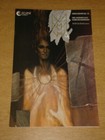Picture 1 of 2

Stock photo


Picture 1 of 2

Stock photo


Eclipse: How the 1919 Solar Eclipse Proved Einstein's Theory of General Relativity by Peter Willis, Darcy Pattison (Hardcover, 2019)

loveourprices2 (117498)
96.4% positive Feedback
Price:
£20.69
Free postage
Returns:
30 days return. Buyer pays for return postage. If you use an eBay delivery label, it will be deducted from your refund amount.
Condition:
The theory talks about how forces push and pull objects in space. Einstein said that the sun's gravity could pull and bend light. If the star's position moved, then it was evidence that that light had bent.
Oops! Looks like we're having trouble connecting to our server.
Refresh your browser window to try again.
About this product
Product Information
In 1915, British astronomer Arthur Stanley Eddington was fascinated with Einstein's new theory of general relativity. The theory talks about how forces push and pull objects in space. Einstein said that the sun's gravity could pull and bend light. To test this, astronomers decided to photograph a solar eclipse. The eclipse would allow them to photograph the stars before and during the solar eclipse. If the star's position moved, then it was evidence that that light had bent. Eddington and his team traveled from England to the island of Principe, just off the African coast, to photograph the eclipse. In simple language, this nonfiction illustrated picture book explains how the push (acceleration) and pull (gravity) of space affects light. Back matter includes information on Einstein, Eddington, and the original photograph of the 1919 solar eclipse. MOMENTS IN SCIENCE COLLECTION This exciting series focuses on small moments in science that made a difference. BURN: Michael Faraday's Candle CLANG! Ernst Chladni's Sound Experiments (2019 NSTA Outstanding Science Trade Book) POLLEN: Darwin's 130 Year Prediction (Junior Library Guild selection, starred Kirkus review) ECLIPSE: How the 1919 Eclipse Proved Einstein's Theory of General RelativityProduct Identifiers
PublisherMims House
ISBN-139781629441252
eBay Product ID (ePID)17046513526
Product Key Features
Number of Pages34 Pages
Publication NameEclipse: How the 1919 Solar Eclipse Proved Einstein's Theory of General Relativity
LanguageEnglish
SubjectAstronomy, Physics
Publication Year2019
TypeTextbook
AuthorPeter Willis, Darcy Pattison
SeriesMoments in Science
FormatHardcover
Dimensions
Item Height216 mm
Item Weight318 g
Item Width216 mm
Volume4
Additional Product Features
Title_AuthorDarcy Pattison, Peter Willis
All listings for this product
Be the first to write a review

























